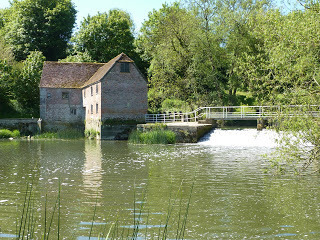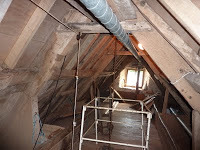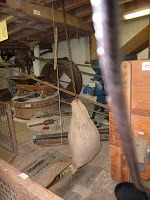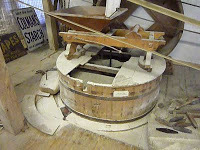Milling
 How did they do that?
How did they do that? You will have seen my earlier post on milling grain at Sturminster Newton, but I thought you might be interested in some views inside the mill itself.
As I may have mentioned before There has been a mill on this site for centuries. A predecessor may even have appeared in the doomsday book. The building is actually two separate mills. The one on the bank for grain, built in 1650 and the wing jutting into the river originally about 1611 (demolished in the 18th c and rebuilt in brick) was used for fulling. This is a method of cleaning the cloth from natural oils and dirt from the local cloth known as swanskin.
This is a small video of the mechanism which raised sacks of grain to the bin loft, with water power, and put into, you guessed it, grain bins. The mill now has a 1904 turbine engine but originally the power would have been produced by the water wheel attached to the mill.

 The sack of grain passes through the stone floor on its way to the bin loft above. Sacks were much larger than that used for the demonstration. These were west of England sacks weighing 18 stones (252 lbs) if it was wheat, 16 stones for barley and 12 stones for oats. Not easily carried up the very steep stairs.You can see the bins in the picture on the right, just and note that some of those roof beams are in the order of 600 or 700 years old, reused time and again. The bins are deliberately low-lipped so it was easier to pour the grain in by hand.
The sack of grain passes through the stone floor on its way to the bin loft above. Sacks were much larger than that used for the demonstration. These were west of England sacks weighing 18 stones (252 lbs) if it was wheat, 16 stones for barley and 12 stones for oats. Not easily carried up the very steep stairs.You can see the bins in the picture on the right, just and note that some of those roof beams are in the order of 600 or 700 years old, reused time and again. The bins are deliberately low-lipped so it was easier to pour the grain in by hand.The grain flowed down from the bins above via a chute, which was opened and closed by pushing wooden bats into a slot in the chute. The grain then passed through a winnower, a series of sieves to get rid of foreign materials. It went back down to the grainfloor (two stories down) where it was rebagged and hoisted up to the bins again where this time it would be directed to the mill stones.
The stone floor is between the ground floor or the grain floor and is where the grinding is done.
 The grain falls into a hopper, supported by a horse, or wooden frame that is supported on a tun or vat, the tun being the large circular wooden box covering the stones. Grain from the hopper is fed into a wooden trough called a shoe, which vibrates and sends a steady stream of grain through a hole in the tun's surface into the millstones. A damsel, so called because of its chattering noise helps maintain the flow of grain.The grain is ground to flour between two millstones. The lower stone is static and is known as the bedstone. The moving stone is the runner. The flour finds its way out from under the runner, into the vat and finally down a hole and back to the ground floor to be bagged off. Bear in mind that all stone ground flour contains a little powdered stone and therefore the millstone must be a hard, fine-textured stone which wears to a smooth powder undetectable in the flour. Derbyshire or Peak stone was a popular choice for millstones. The French Buhr stone quarried near Paris was the very best of all.
The grain falls into a hopper, supported by a horse, or wooden frame that is supported on a tun or vat, the tun being the large circular wooden box covering the stones. Grain from the hopper is fed into a wooden trough called a shoe, which vibrates and sends a steady stream of grain through a hole in the tun's surface into the millstones. A damsel, so called because of its chattering noise helps maintain the flow of grain.The grain is ground to flour between two millstones. The lower stone is static and is known as the bedstone. The moving stone is the runner. The flour finds its way out from under the runner, into the vat and finally down a hole and back to the ground floor to be bagged off. Bear in mind that all stone ground flour contains a little powdered stone and therefore the millstone must be a hard, fine-textured stone which wears to a smooth powder undetectable in the flour. Derbyshire or Peak stone was a popular choice for millstones. The French Buhr stone quarried near Paris was the very best of all.When a stone wore down it would be the millers responsibility to dress the stones. He would remove all the wooden accessories, use a stone crane or winch, levers, wooden blocks etc to lift. to turn over and place the running stone on the floor. He would then mark the stones for dressing using a swan's feather dipped in raddle - an earth colour obtained from Cornwall or the Forest of Dean - then chip out the grooves and flatten the high spots with a steel pick held in a wooden handle called a bill or a thrift. Then he had to put it all back together. This could happen fairly often too. But the stones themselves could last as long as 0 years.
Mill stones vary but can weight up to three quarters of a tone each. They must be artificially roughened with grooves in order to grind rather than slide over the round grains as if they were ball bearings. A miller had to be careful not to let the stones grind against each other (run out of grain) or they might create a spark. Flour catches alight very easily and many mills burned down. This is the sound of the grain being turned into flour.
Hope you enjoyed our trip to the Mill at Stourbridge. Until next time, Happy Rambles
Published on August 18, 2011 02:00
No comments have been added yet.



